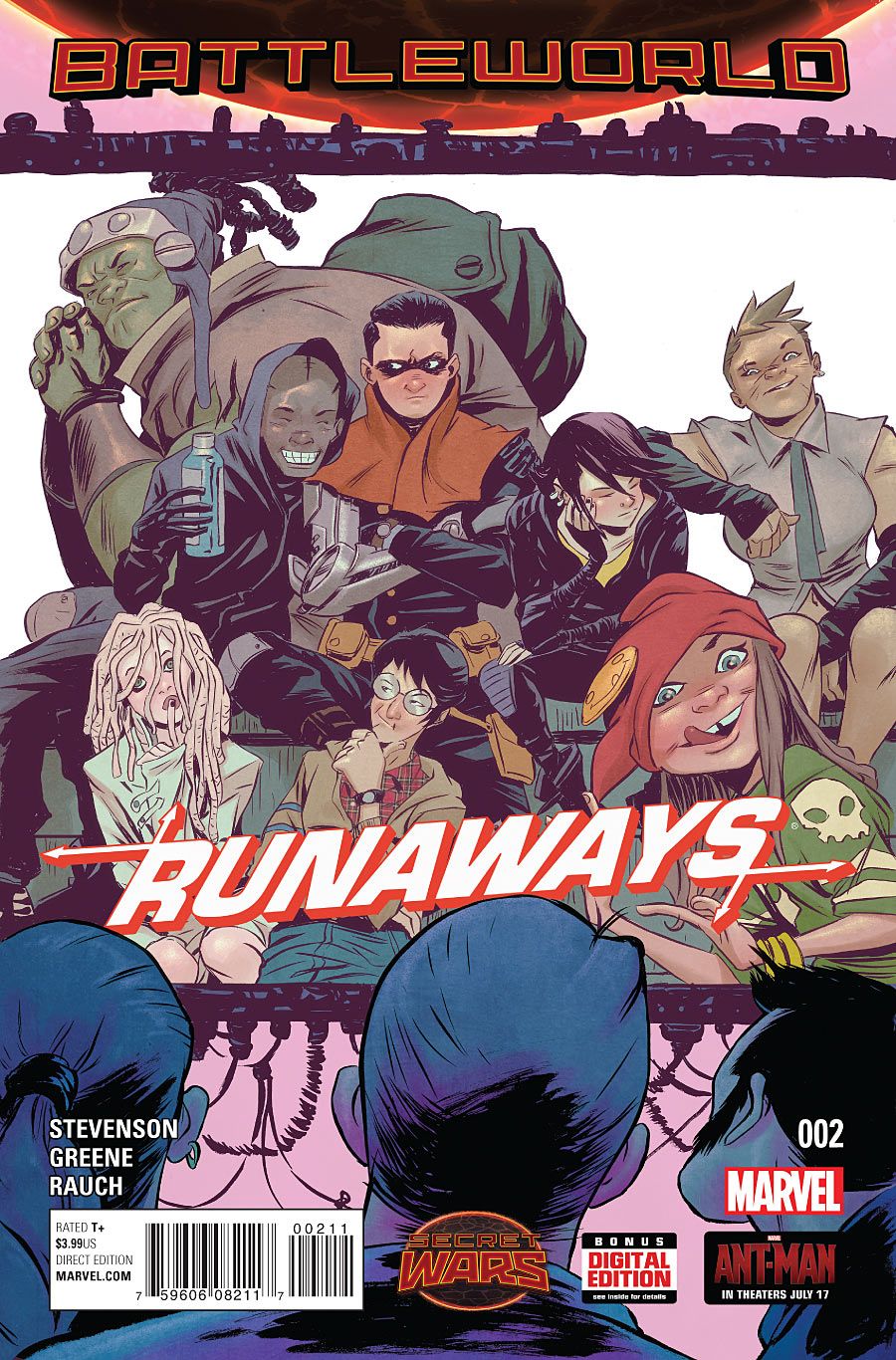"Runaways" by Noelle Stevenson and Sanford Greene is one of the best tie-ins titles to come out of the "Secret Wars" event. Stevenson's dialogue and characterization is its primary strength. "Runaways" #2 begins with a low-key two-page opening scene that establishes that Team Puce made it to the opening ceremonies. As all exam-takers each recite a creepy vow of loyalty to Lord Doom, Greene re-introduces each character by panning over the crowd.
Stevenson's dialogue for Jubilee restores the character's classic joie de vivre. Mall Rat-era Jubilee is back -- overconfident, mischievous and irrepressible - and, without parental figures like Wolverine or Professor X, she's got an even brattier edge. I haven't liked reading the character so much in ages. Stevenson really knows how to write dialogue for teenagers. Pixie, the responsible worrywart, is constantly upstaged by Jubilee. A little too mechanically, Stevenson installed her to be Jubilee's friend and foil.
Jubilee and Sanna's antagonism serves a similarly structured but opposing role. "Runaways" #2 begins and ends around the emotional tension between them. Sanna's need to win and her investment in authority provides another contrast to Jubilee, and their fundamental disagreements hold even after a life-changing plot twist. Stevenson tries to give every character some screen time, but characters like Molly or Skaar remain one-dimensional, while Jubilee and Amadeus dominate their scenes. That makes sense this early on in the story, though. Instead of trying to develop a large cast evenly, Stevenson picks a few key personalities and structures the plot around them.
In a locker room scene, Greene's facial expressions are vehicles for Stevenson's relationship-building, but his perspective switch in the fifth panel is unnecessary and disrupts the flow of conversation. No change or an overhead shot would've been better than a tilted low angle shot, which has too many horror-movie associations to be a neutral move. It also confuses the reader by moving them to the vantage point of Pixie's hip for no reason.
Rauch's color palette is overly determined to project a grim atmosphere. He doesn't do justice to Green's linework and shading, because his monotones flatten backgrounds and details. Greene's panels do look cluttered due to composition choices, but monotones are an inelegant counterweight. However, Rauch's use of neon pink is very smart. Paired with turquoise walls and floor, it adds excitement and also makes the action cleaner and easier to follow.
Greene's fight scenes have strong forward motion, and the locker room perspective hiccup was an exception to his generally smooth transitions. His facial expressions are just as strong for combat scenes as they are for talking heads scenes. Amadeus' face as he parries a blow in a swordfight is hilarious, and Greene perfectly matches Stevenson's beats for Tandy's jibe afterwards. The most poignant and symbolic panel, though, is the close-up of Jubilee's face after the team makes a shocking discovery. Jubilee's reaction and her reply to Sanna point to a new direction. This is where and when Team Puce becomes the Runaways, and Greene is able to do justice to the moment.
The revelation itself is very old, seen before in dystopian science fiction in multiple media. Even more broadly, it can be classified as simply an abuse of authority, one so great that there is no further justification needed for rebellion by the narrators or heroes. From "One Flew Over the Cuckoo's Nest" to "Hunger Games," institutional abuse of power provides both a mission and teamwork-glue to the oppressed. Stevenson and Greene are able to give the plot twist an initial jolt of shock, but it quickly wears off, reverting to seeming predictable and derivative afterwards. That's no matter, however; it has served its purpose and the Runaways are off. The highlights of the title remain the humor, dialogue and the team dynamic.

